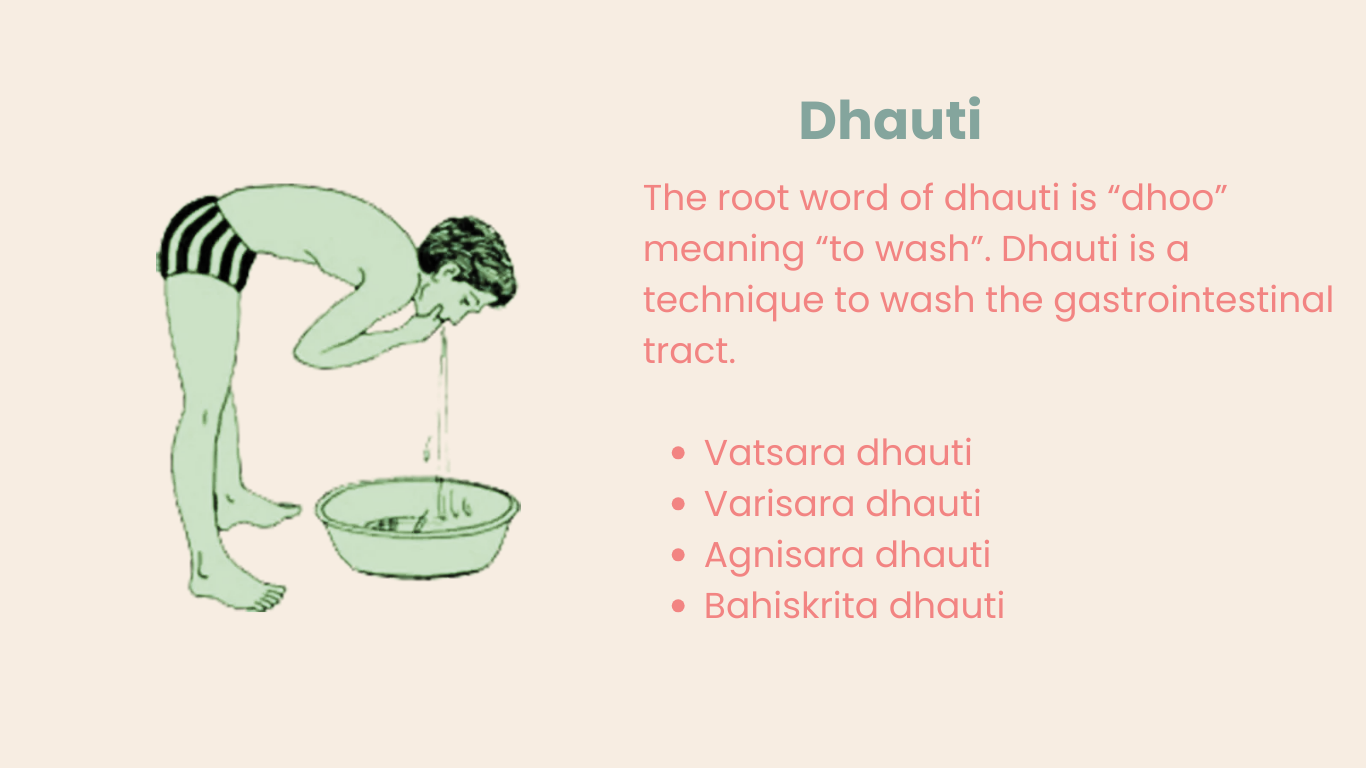Antar Dhauti: A Yogic Secret to Intestinal Cleansing
The root word of dhauti is “dhoo” meaning “to wash”. Dhauti is a technique to wash the gastrointestinal tract. The technique chosen to perform dhauti depends on your body’s constitution according to Ayurveda, including vata, pitta and kapha.
Detailed Explanation of Antar Dhauti: Types, Technique, Benefits
Dhauti can be divided into four parts.
The first practice of dhauti is antar dhauti which means internal cleansing and is the topic of this article. For this technique different tools can be used to purify the body - air, water and fire.
Depending on the technique and element used for antar dhauti, it can be further divided into four parts.
1. Vatsara dhauti
“Vata” means “air” and “sara” means “element”
For Vatsara dhauti the element air is used to cleanse the intestines and stomach. Through the deep breathing process accumulated dust, toxic gases can be eliminated and the digestive system is been activated.
Technique of Vatsara dhauti
1. To perform vatsara dhauti come into sukhasana, padamasana, siddhasana, or siddhi yoni asana, straightening the spine and placing the hands on the knees.
2. Forming the shape of a crow's beak on your lips. Start by exhaling through the nose, followed by a gradual, water-like intake of air through the lips to try and fill the abdomen – like swallowing air.
3. Continue to add as much air as you can to the stomach. Once the stomach is totally full, keep the air inside for a minute or two and let your muscles relax and rotate your abdomen for a while. Finally, release the air by belching
Awareness of Vatsara dhauti
When using this technique, we always do it while seated. The exercise shouldn't be done standing up. When seated the physical position contracts the intestines, providing a form of barrier that retains the air in the stomach rather than when we are standing and the intestines are open and air may freely enter them.
Secondly, inhale the air into the stomach. It needs a lot of practice to get control over throat muscles to fill the stomach with air. Once the stomach is filled with air than hold the air inside. During this process breathe continuously through the nose for normal respiration. Because there is no effect of this practice on our lungs , its only to cleanse upper gastrointestinal tract.
Avoid this practice 2-4 hours after a meal otherwise at any time of the day can be performed daily.
Benefits of Vatsara dhauti
- This routine helps to expel wind and gas while stimulating the digestive tract.
- It eliminates pain and irritation brought on by acidity in the stomach and esophagus, regulates the production of gastric juices, mucus, and acid.
- It purifies the body and activates the gastric fire which helps to digest food.
Do you want to know more about the top 15 modern yoga styles - be read this article
2. Varisara dhauti
“Vari” means “water” and “sara” means “element”
The purpose of Varisara dhauti is to remove feces from the intestines. Because this method thoroughly cleaned the entire alimentary canal from the mouth to the anus, toxic substances are removed from the body and the entire system is regenerated. Many people suffer from constipation due to mental and emotional stress, to poor life habits, improper diets and reduced activity. By using this method of shatkarma, we can treat constipation and revitalize the body.
Technique of Varisara dhauti
On the day of Varisara dhauti, avoid doing asana in the morning and do it in a place close to a bathroom. To begin, we must prepare salty, lukewarm water. Add around two tablespoons of salt per liter of water and prepare 4-5 liters. The salt should dissolve properly.
- Immediately drink four glasses of the salty, lukewarm water. Then, a series of asanas should be actively performed eight times each. Continuously perform Tadasana, Tiryak Tadasana, Kati Chakrasana, Tiryak Bhujangasana, and Udarkarsanasana. Once more, drink two to four glasses of salty, lukewarm water, and dynamically do the five asanas without pausing. After that, use the restroom without any strain. If there is no bowel movement then perform a third round and go back to the bathroom.
First, regular feces and then liquid wastes are evacuated. Then, water that is yellow in color emerges, expelling pitta. Keep moving quickly; otherwise, the water begins to be absorbed from the digestive system into the bloodstream and the pressure inside the abdomen will lessen.
- Additionally, trapped fragments of old, dried waste that had become stuck to the intestines' walls over years are released. Continue drinking water and doing the asanas until clear water comes out, or until you finished 16 to 20 glasses of water and practically clear water has come out, at which point you stop the practice. . After doing this, one should rest shavasana but avoid dozing off and two to three hours later, have some khichari, a yogic dish made of rice and lentils and cooked with water, salt, and turmeric. Additionally, add some clarified butter to it at the end to lubricate our intestines.
Benefits of Varisara dhauti
This is the most effective way to clear the body from toxins and digestive system issues. It also makes the body pure and light which is suited for continuing the yoga practice.
Precaution of Varisara dhauti
- Avoid this practice, when suffering from peptic ulcers, hernia, tachycardia, dizziness, bleeding piles or any kind of heart issue
- There is no upper age limit but it should be avoided by children under 16 years
- Do not practice while menstruating or during pregnancy
Precaution after performing varishara dhauti
- Don’t sleep after the practice
- Don’t take a bath or shower for at least three hours after practice
- Don’t drink water or other liquids until at least two hours after the first special meal, even if very thirsty. Drinking before the prescribed period will dilute and wash away the new protective layer being formed in the digestive tract.
3. Agnisara dhauti
“Agni” means “fire” and “sara” means “element”
Agnisara kriya also known as vahnisara dhauti actives the digestive fire, massaging all the abdominal organs and enhancing their digestive capacity and stimulating the digestive fire. retaining prana and one hundred times (expansion and contraction of the abdomen take place) but this does not mean that eery practioner has to perform this practixe one hundred times. It should be done as many times as is suitable for the individual.
Technique of Agnisara dhauti
We have the option of doing this dhauti in either a seated or standing position.
Sit in any comfortable meditation position, such as padmasana, siddhasana, or vajrasana or stand with your feet hip width apart.
Bring your hands to your knees while maintaining a straight, erect spine.
Take a deep breath in through your nose and exhale completely through the mouth. Hold your breath outside and engage jalandhara bandha. Rapidly pull the navel against the spinal column and let go again. Do this for as long as you can retain your breath outside.
Release the jalandhara bandha and take a slow, deep breath in through your nose to finish this round.
Start with 2 to 4 rounds of each 15 contractions and expansions and then gradually increase the round after consistent practice.
Precaution of Agnisara dhauti
- It activates the nervous system and has an immediate impact on the cardiovascular and respiratory system. Therefore, anyone with heart disease, high blood pressure, or asthma should avoid it.
- Agni sara kriya exerts significant pressure on the abdominal wall, it is not recommended for anyone with hernias, ulcers, or pregnancy.
- Don’t perform while menstruating.
Benefits of Agnisara dhauti
- Constipation, indigestion, hyperacidity, hypoacidity, flatulence, stomach worms, and other digestive system ailments are all prevented and treated by it, and all the abdominal organs are massaged and toned.
- Agnisara kriya awakens the manipura chakra, which is the first of the body's pranas to awaken, which helps to alleviate depression. It also activates the nervous system, which is necessary for the awakening of kundalini and prana systems.
4. Bahiskrita dhauti
The human body is incredibly powerful, but it's important to understand it and appreciate its potential. There is a common misconception that if the breath is held for a longer period of time, the person may potentially pass away. A siddha yogi may function without breathing for up to 30 minutes while still being alive, however if the breath is withheld forcibly without practice, the body and face will turn black or blue. In this dhauti we try to hold breath.
Technique of Bahiskrita dhauti
There is two parts of this dhauti
Technique 1 - Bahiskrita dhauti
In the first technique, the lips are pursed and air is inhaled via the mouth much like when drinking water. Bringing the lips in this position is called `kaki mudra’ Now hold the breath for half a yama, which is equal to one and a half hours. Although it is difficult to understand that you can hold the breath for an extended period of time, many texts have stated that this suggests breathing is stopped for one and a half hours.
- It actually means that the air should be kept for that long in the stomach and alimentary canal. Therefore, it is essential that these verses be interpreted correctly.
- The sphincter between the esophagus and the stomach prevents the air held in the stomach from coming up . It will move inside in the stomach and intestine, mix with toxins in the form of gases, and finally must be ejected through the anus.
Technique 2 - Bahiskrita dhauti
- After using the first approach, submerge yourself in water until your navel and suck water through your anus. In ancient times this was performed in a river.
- Hold the water for few minutes and then expel the wastes through the anus. The anus is then covered with a small amount of ghee or oil.
Please be aware that these are ancient and advanced cleansing techniques that should only be performed under the guidance of an experienced teacher.
Benefits of Bahiskrita dhauti
- It is said that by practicing this dhauti, one attains a body like that of a divine being.
- Its help to create sensation in the nadis around the anus and the pranas are awakened in the body.

Anatar Dhauti Mastery at Anandam Yoga School's Conscious Living Retreat
Embark on a transformative journey of self-discovery and holistic well-being with Anandam Yoga School's Conscious Living Retreat. Join us to delve into the profound practice of Anatar Dhauti, a ancient yogic technique for inner purification. Under the guidance of experienced yoga instructors, you'll learn the intricacies of this powerful practice, fostering a deeper connection between mind, body, and spirit.
Immerse yourself in the serene surroundings of our retreat center, where the ancient wisdom of yoga meets modern wellness. This yoga teacher training Germany offers a unique opportunity to not only master Anatar Dhauti but also to embrace conscious living. Through a blend of yoga, meditation, and mindful living practices, you'll cultivate a harmonious balance within yourself and with the world around you.
Join like-minded individuals on this empowering journey towards self-awareness and vitality. Anandam Yoga School invites you to unlock the potential of Anatar Dhauti, paving the way for a more mindful and fulfilling life. Embrace the transformative power of yoga at our Conscious Living Retreat and rediscover the joy of living in harmony with your true self.

